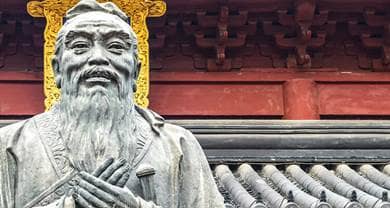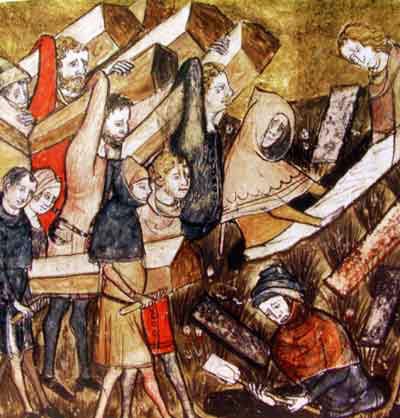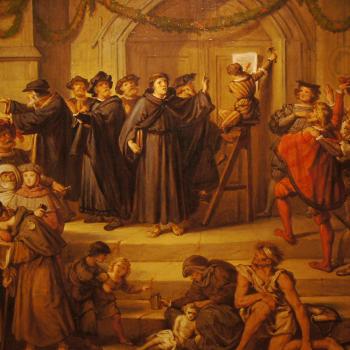- Trending:
- Pope Leo Xiv
- |
- Israel
- |
- Trump
- |
- Social Justice
- |
- Peace
- |
- Love

RELIGION LIBRARY
Confucianism
Schisms and Sects
While there were differing interpretations of Confucianism and disagreements about its meaning, enduring sects with independent organizational structures never formed in the case of Confucianism. During Confucianism's late antique period (220-907 C.E.), the tradition responded to the proliferation of Taoist movements, the introduction of Buddhism, and the waning of elite support for Confucianism. It is more accurate to describe this aspect of Confucianism's history in terms of the appropriation of non-Confucian elements, such as worship directed at deities rather than ancestors and abstract thought devoted to metaphysics rather than ethics, for Confucian purposes.
 After the fall of the Han dynasty in 220 and the commencement of the "period of disunity" (220-581 C.E.), the rulers of a number of former Han territories fought for mastery of a reunified empire, sustaining centuries of disruptive conflict. The eclecticism and syncretism of the Han era continued as a form of Taoist speculation called xuanxue (abstruse [or dark] learning, sometimes called Neo-Taoism) flourished, and intellectuals such as the precocious Wang Bi (226-249 C.E.) mixed their Confucian reflections with Taoist cosmology and metaphysics. Even more momentous was the arrival of Buddhism in China. The Chinese intellectual world was not the same after the introduction of the Buddha's teachings. Although Confucianism never lost its pride of place in the Chinese state or family, it is accurate to say that the most acute religious, artistic, and philosophical mind-hearts in China from the 3rd to the 10th centuries devoted themselves to the appropriation and Chinese transformation of the Buddhist dharma (law or teaching). Great temples were created. The huge Buddhist sangha (monastic community) was formed. Entirely new and elaborate schools of Buddhist thought such as Tiantai (Heavenly Terrace), Huayan (Flower Garland), Jingtu (Pure Land), and Chan (Meditation, known in Japan as Zen) were created and sustained. The rise and flourishing of this Chinese Buddhist world formed the backdrop for new epochs of transformation of the Confucian Way.
After the fall of the Han dynasty in 220 and the commencement of the "period of disunity" (220-581 C.E.), the rulers of a number of former Han territories fought for mastery of a reunified empire, sustaining centuries of disruptive conflict. The eclecticism and syncretism of the Han era continued as a form of Taoist speculation called xuanxue (abstruse [or dark] learning, sometimes called Neo-Taoism) flourished, and intellectuals such as the precocious Wang Bi (226-249 C.E.) mixed their Confucian reflections with Taoist cosmology and metaphysics. Even more momentous was the arrival of Buddhism in China. The Chinese intellectual world was not the same after the introduction of the Buddha's teachings. Although Confucianism never lost its pride of place in the Chinese state or family, it is accurate to say that the most acute religious, artistic, and philosophical mind-hearts in China from the 3rd to the 10th centuries devoted themselves to the appropriation and Chinese transformation of the Buddhist dharma (law or teaching). Great temples were created. The huge Buddhist sangha (monastic community) was formed. Entirely new and elaborate schools of Buddhist thought such as Tiantai (Heavenly Terrace), Huayan (Flower Garland), Jingtu (Pure Land), and Chan (Meditation, known in Japan as Zen) were created and sustained. The rise and flourishing of this Chinese Buddhist world formed the backdrop for new epochs of transformation of the Confucian Way.
 Toward the end of the Tang dynasty (618-907 C.E.), a number of Confucian scholars saw their task as defending the Confucian Way against the challenge of Buddhism. The advent of Buddhism in China redefined Chinese political, religious, and social norms in a number of ways. Politically, China's membership in the elite club of Buddhist nations elevated cosmopolitanism above native values in defining the identity of the Chinese state. Religiously, Buddhism emphasized karmic retribution, cyclical rebirth, and celibate withdrawal from family life (as opposed to a this-worldly ethics of filial obedience to elders and superiors) as efficacious spiritual paths. Socially, Buddhism offered a critique of age, class, and even gender hierarchies, and challenged the ancient Chinese arrangement whereby the state and the family were the final arbiters of religious values. The three most famous Tang Confucian critics of Buddhism were Han Yu (768-824 C.E.), Li Ao (772-841 C.E.), and Liu Zongyuan (733-819 C.E.). Along with continuing the Han Confucian interest in government service, commentary, family ritual, and historical writing, these scholars framed the major lines of the Confucian response to the Buddhist philosophical and religious challenge with a renewed interest in cosmology, self-cultivation, and social ethics. Despite the protests of Confucians such as Han Yu, however, the eventual state persecution of Buddhism in 845 C.E. was not due to Confucian agitation, but rather the result of Taoist influence on the imperial throne as well as increased suspicion of foreigners in the wake of the An Lushan uprising of 755-763 C.E.
Toward the end of the Tang dynasty (618-907 C.E.), a number of Confucian scholars saw their task as defending the Confucian Way against the challenge of Buddhism. The advent of Buddhism in China redefined Chinese political, religious, and social norms in a number of ways. Politically, China's membership in the elite club of Buddhist nations elevated cosmopolitanism above native values in defining the identity of the Chinese state. Religiously, Buddhism emphasized karmic retribution, cyclical rebirth, and celibate withdrawal from family life (as opposed to a this-worldly ethics of filial obedience to elders and superiors) as efficacious spiritual paths. Socially, Buddhism offered a critique of age, class, and even gender hierarchies, and challenged the ancient Chinese arrangement whereby the state and the family were the final arbiters of religious values. The three most famous Tang Confucian critics of Buddhism were Han Yu (768-824 C.E.), Li Ao (772-841 C.E.), and Liu Zongyuan (733-819 C.E.). Along with continuing the Han Confucian interest in government service, commentary, family ritual, and historical writing, these scholars framed the major lines of the Confucian response to the Buddhist philosophical and religious challenge with a renewed interest in cosmology, self-cultivation, and social ethics. Despite the protests of Confucians such as Han Yu, however, the eventual state persecution of Buddhism in 845 C.E. was not due to Confucian agitation, but rather the result of Taoist influence on the imperial throne as well as increased suspicion of foreigners in the wake of the An Lushan uprising of 755-763 C.E.
 Following the collapse of the Tang dynasty in 907 C.E. and the reunification of China under the Song dynasty (960-1279 C.E.), there occurred a renaissance of Confucianism. The traditions that arose during this period of renewal often are called "Neo-Confucian" in order to distinguish them from the traditions of Confucianism's classical, imperial, and late antique periods. The renewed brand of Confucianism developed at this time led to the reformulation of the Confucian canon. By the end of the Song dynasty, it had grown beyond the Wujing to include thirteen early works (including the recorded versions of both Kongzi's and Mengzi's teachings) that were considered the reliable records of the thoughts, history, poetry, divinations, words, rituals, and deeds of the early sage rulers of China. Moreover, it was during this period of renewal that Confucianism expanded most forcefully and successfully beyond China into Vietnam, Korea, and Japan.
Following the collapse of the Tang dynasty in 907 C.E. and the reunification of China under the Song dynasty (960-1279 C.E.), there occurred a renaissance of Confucianism. The traditions that arose during this period of renewal often are called "Neo-Confucian" in order to distinguish them from the traditions of Confucianism's classical, imperial, and late antique periods. The renewed brand of Confucianism developed at this time led to the reformulation of the Confucian canon. By the end of the Song dynasty, it had grown beyond the Wujing to include thirteen early works (including the recorded versions of both Kongzi's and Mengzi's teachings) that were considered the reliable records of the thoughts, history, poetry, divinations, words, rituals, and deeds of the early sage rulers of China. Moreover, it was during this period of renewal that Confucianism expanded most forcefully and successfully beyond China into Vietnam, Korea, and Japan.
Study Questions:
1. What role did Buddhism play in the development of Confucian thought?
2. What role did Taoism play in the development of Confucian thought?
3. What accounts for Confucianism's loss of influence in the early medieval period?
4. What accounts for Confucianism's return to influence in the late medieval period?










